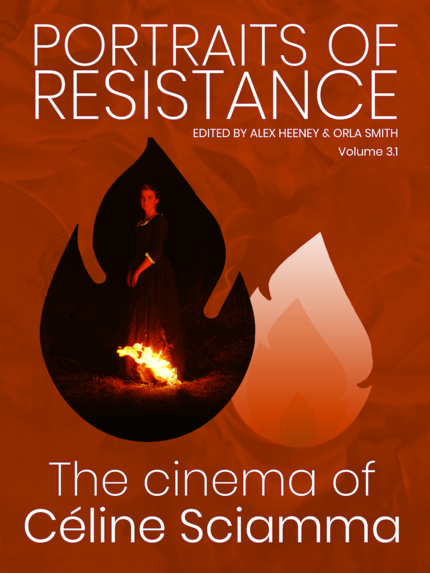Book Review: PORTRAITS OF RESISTANCE Takes A Close Look at Céline Sciamma

By now, audiences in much of the world have been able to witness (either in cinemas or via streaming) the sublime beauty that is Portrait of a Lady on Fire. It was certainly one of my favourite films of the past year (you can read my review), one that I've now watched four times and haunts me almost every day (perhaps more so now that I'm proverbially 'trapped' with the person I love, in a space where time has little meaning). French filmmaker Céline Sciamma's film might have garnered her the most international attention in her career thus far, but it is her fourth feature, and the both a culmination of her previous work, and an entity on its own.
Comprehensive books on female filmmakers are still lacking, even for those such as Sciamma, who are already having a tremendous impact on French and world cinema. For those who are have just discovered Sciammi, or might have become familiar with her third fearture Girlhood from 2014, Seventh Row have published an ebook on the filmmaker's work thus far. Co-edited by Alex Heeney and Orla Smith, the book features an introduction to Sciamma's work, essays on the themes that dominate her films, the presence and representation of women and queer identities, interviews with Sciamma, as well as actresses Noémie Merlant and Adèle Hanael. For those with little or no knowledge of Sciamma's films, it's a great read to know it more; for those that do, it's a welcome addition to a film library with some in-depth and considerate analysis.
In her forward, Smith relates that the idea for a book on Sciamma took root after Heeney interviewed her for Girlhood. She notes how Portrait drew more people's attention to the director outside of France, and how Sciamma's oeuvre was now such that a book was not only timely, but needed, to further know and understand her impact. The first section, while it begins of course with an introduction, acts in its entirety as an entrance for the reader: it's as if you are entering a house, with the large hallway offering portraits (no pun intended): first in Brett Pardy's essay, on the filmmaker herself, her work in film, her approach, and the culmination in her most recent work. This is followed by a look at the 10 best scenes in Sciamma's films, as selected by Smith and Heeney. This gives insight into Sciamma's use of cinematography, light, and sound, and how these have come to form her style and evocation of her stories.
Part Two is a series of essays on the images of resistance, as the editors have titled the book, and what they mean in Sciamma's first three films: specifically, how her work focuses on these young outsiders, and how they attempt to find their own paths, especially in a patriarchal society. Ben Flanagan examines how the characters in Water Lilies try, and often fail, to find their own existence within the conformity forced upon them in a male-dominated world. Lena Wilson looks to how Sciamma portrays gender non-conformity in Tomboy, what it might mean for a young person who is trying to understand how to exist in a world which insists on labels, when he doesn't yet understand their full meaning. For Girlhood, Heeney's interview with the filmmaker, her process in creating the film, and how she hopes audiences connected with it; this is paired with Smith's analysis of the film's choreography, as music figured prominently. Indeed, all the essays in this section note Sciamma's close attention to the female body and how it exists in space: in a room, in the outdoors, alone and with other people, and how these bodies wish to be versus how they are percevied.
Parts three and four take an indepth look at Portrait of a Lady on Fire. While the most known of Sciamma's films, keeping this to the second half of the book works well: those who love the costume drama will now understand the path Sciamma took to it, how some of her methods changed, and how her approach to the themes and ideas that interest her have evolved. First, there is another interview with Sciamma, and then an interview with the film's sound editor, Valérie Deloof. Sound editing is often under appreciated, and given its importance in this film, it's a great insight not only to the form and technique, but its integral nature to the cinema experience. Then there are two essays on the acts of looking and seeing: one on how Sciamma flips it to a female gaze, another to the the image of Hanael. Interviews with Hanaél and Merlant add to how we understand not only their specifric processes and experiences of working on this film, but how actors work, both in a period film, and a film with such specific needs and working environments.
When we're looking for a book on a filmmaker, especially one whose work is still relatively new, we look for certain things: a brief introduction on how the filmmaker got their start, what other projects might have led to their own creations, their influences, how their ideas and techniques began and evolved, and different perspectives on their work, its themes, and philosophies. Portraits of Resistance covers enormous ground, reading Sciamma's work as queer cinema, women's cinema, European cinema, looking at the both the stories and the aesthetics, and how Sciamma has already created distinct and unique films with a singular voice. Not only is it a grat introduction for any who want to learn more about the filmmaker, it will be a cornerstone for any future Sciamma scholarship.
Portraits of Resistance: The Cinema of Céline Sciamma is published by Seventh Row. You can purchase a copy here.







